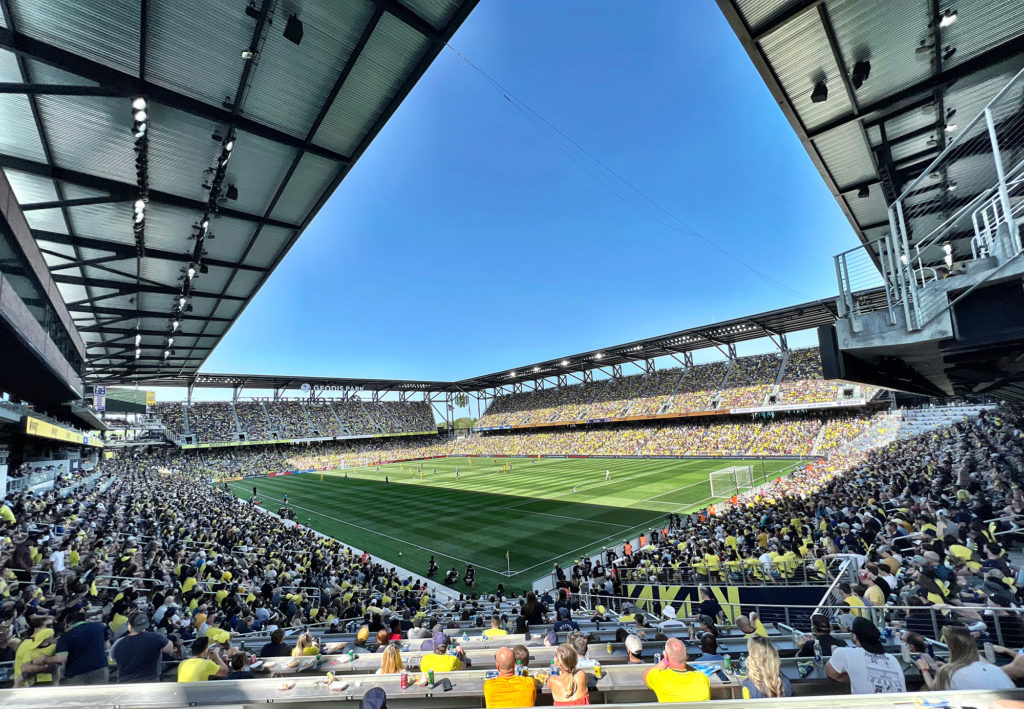
A shining shrine to soccer now sits high above the Music City, as GEODIS Park, new home of Nashville SC, opens for the 2022 season and immediately raises the bar on MLS stadiums in several ways.
With commanding views of the Nashville skyline and the surrounding Wedgewood-Houston neighborhood, the $335-million GEODIS Park makes an impact from afar as you approach from any side. We all know a stadium set on a hill cannot be hid, and that certainly goes for an MLS stadium. Seating 30,000, GEODIS Park footprint is substantial, and that capacity represents the largest capacity for a U.S. soccer-specific stadium.
There is nothing soft about this stadium, featuring an industrial design highlighted by black steel and dark woods, with no apparent curves and everything set at an angle. Forget about the graceful curves surrounding the pitch at Allianz Field or the curvy exterior, roof and bowl at TQL Stadium. GEODIS Park features a very angular design, with right angles coming at every corner of the concourse and the exterior. Angled cutouts beckon you at entrances.
We were there for Opening Day, when Nashville SC Vice President, Communications Cristina Maillo Belda gave us a tour of the stadium before opening, on a day when all 30,000 seats were accounted for and the attendance was officially reported at 30,019. Despite that large crowd, the concourses (for the most part; we’ll get into that a little later) were not crowded to the point of smothering, and most fans could access concessions without a huge hassle—even at halftime, where fans flood the concourses and beer lines. The stadium is deceptively intimate: you are on top of the action even at the most remote sections, thanks to the pitch of the upper-deck seating.
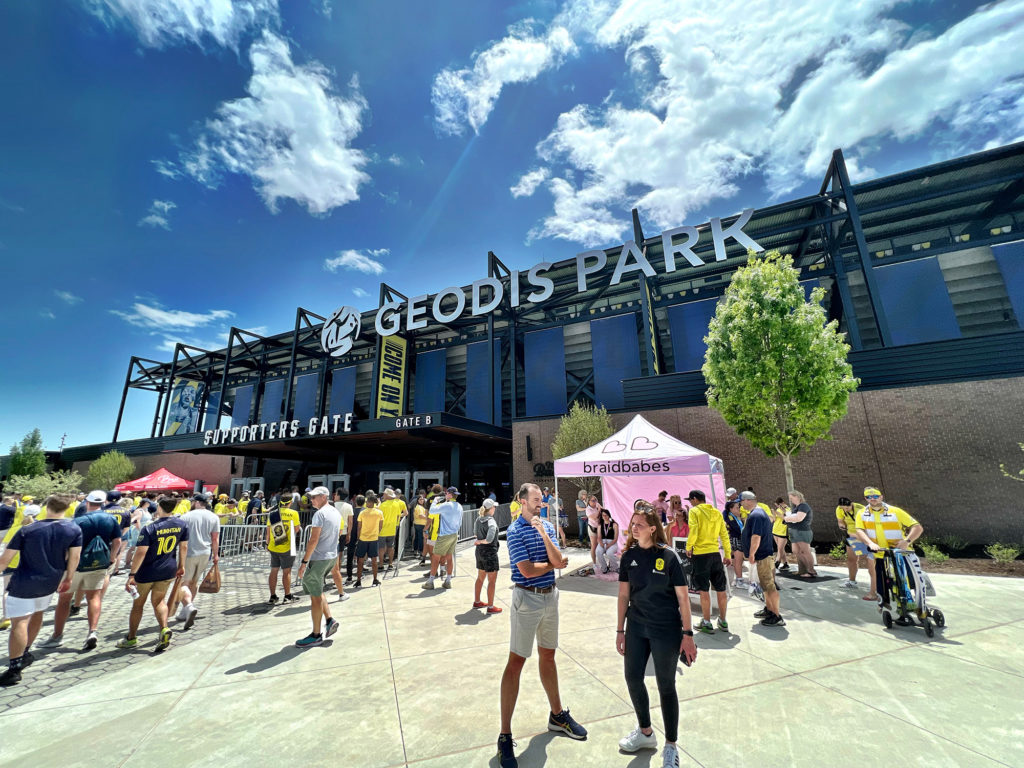
Despite all the right angles, it would not be accurate to term GEODIS Park’s design as boxy, as the layout is not symmetrical. Three sides of the stadium—the two ends and the east side—feature full seating on two decks. The two-decked east side also features a 65-foot-wide concourse, with permanent concessions on the outer wall and an assortment of portables on the pitch side. On the north side the six supporters clubs have their own dedicated entrance (there is a total of seven entrances) leading directly to a 3,200-capacity supporters section, with safe seating that meets FIFA standards. A signature design element is at Gate C, where a team logo is hung.
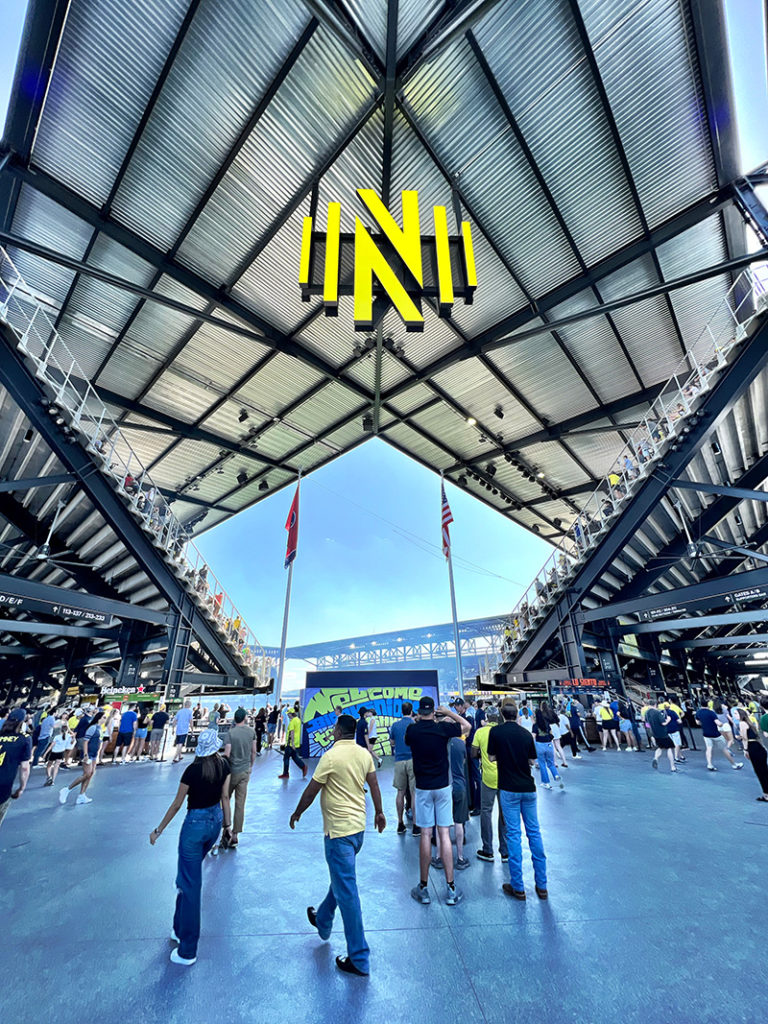
The west side of the concourse is where premium seats rule the day, including three concourse-level clubs and 18 loge boxes at center pitch. The second level features a large press box, suites and the Captain’s Club. Across that entire side of the stadium are 27 suites, four clubs and about 4,000 premium seats.
These four clubs are designed to attract a wide variety of fans. The EODIS WeHo Club is a music-themed lounge with its own stage and pre-match live music, and also includes an exhibit courtesy of the National Museum of African-American Music. The Lo Siento Goal Post Club is a large sports-themed lounge, features walls of televisions broadcasting sports of all sorts, as well as some sports memorabilia. The Valkyrie Premier Club is a VIP-level lounge decorated with plenty of brass, dark woods and lounge-style season. These are all on the concourse level. A level above is the C-Spire Captains Club, an intimate dining and seating lounge highlighting the most historic team captains from around the globe. It features outdoor seating for 200 in addition to the indoor seating.
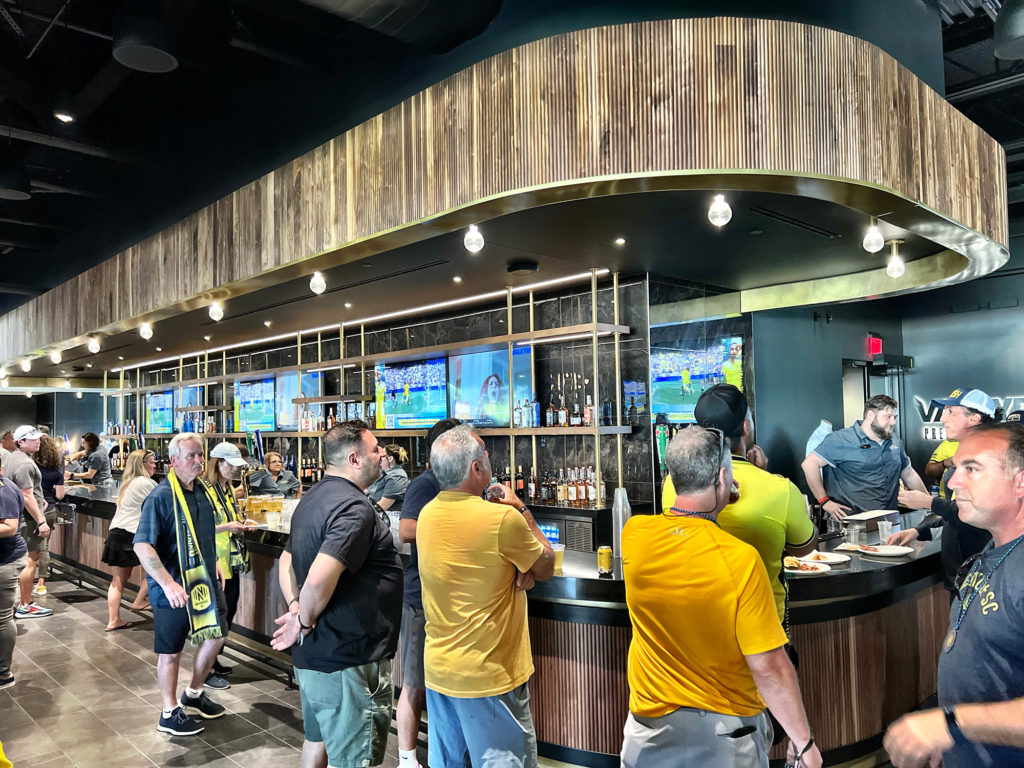
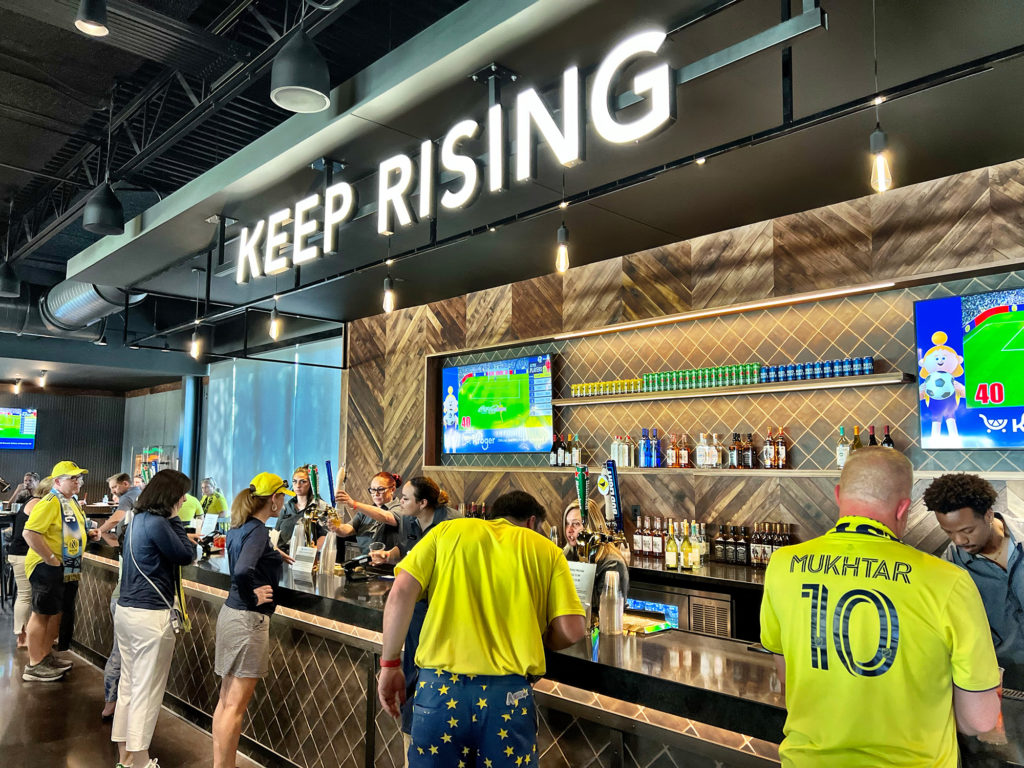
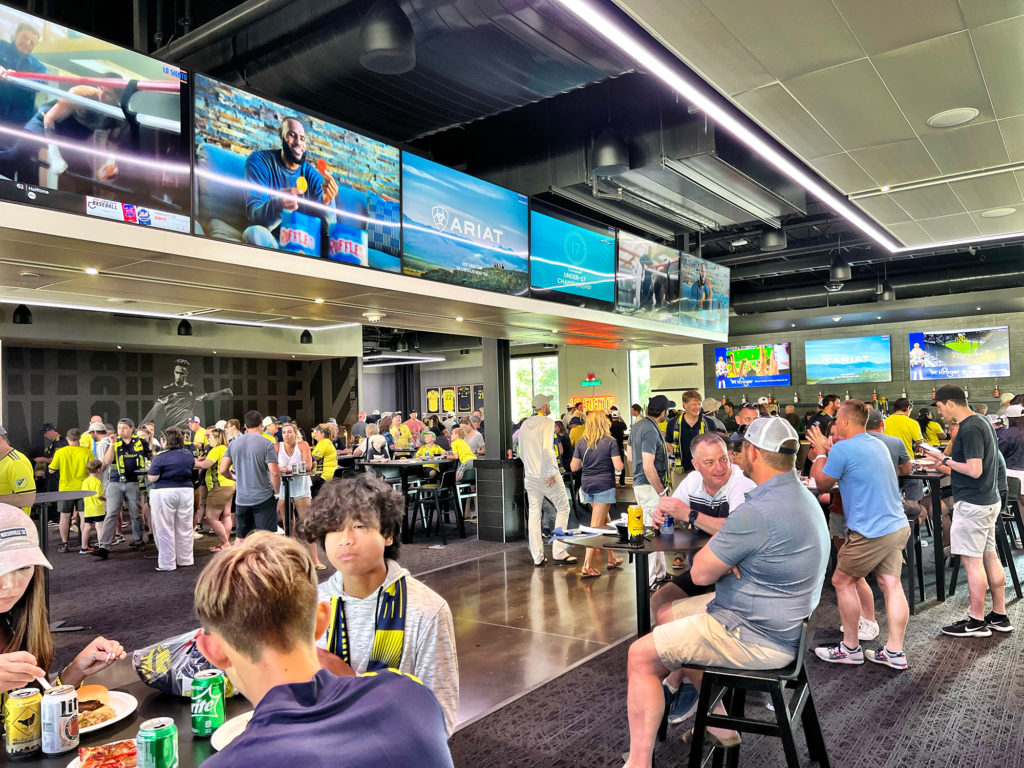
The wide variety of clubs can be reconfigured for specific events. This points to one design goal for GEODIS Park: its use as an event center throughout the year. Nashville is built around the entertainment and hospitality economies. The size of 30,000—which leads to a capacity of 27,000 or so for concerts—puts GEODIS Park at a sweet spot: much more intimate that Nissan Stadium but larger than Bridgestone Arena at a venue that’s designed to accommodate large-scale events.
The concourse design is a little unusual, as one 360-degree concourse pretty much serves all the seating in the stadium. Though it may technically be a 360-degree concourse, in practice is is not. The concourse narrows considerably on the west side, and access is limited to those holding club and suite tickets. That led on Opening Day to bottlenecks at each end of this club concourse, with ticketholders in the rest of the bowl assuming they could walk all around the pitch—it’s unusual to find a stadium not allowing full access to the entire main concourse.
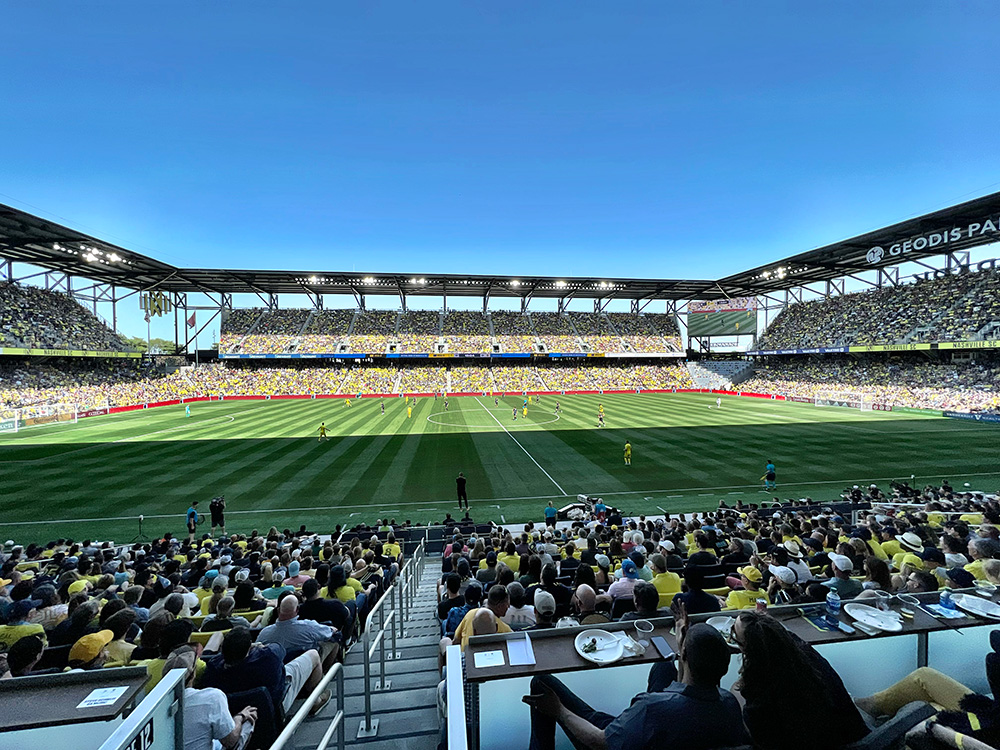
And, in fact, the existence of bottlenecks at each end of the club area was one of the few instances where fans were confused about where to go on Opening Day. As noted, there are seven entrances to the stadium, and the lines for 30,000 fans entering the stadium didn’t seem too out of control. Part of that was an early gate opening—two hours before the Philadelphia Union-Nashville SC match started—and part was due to some conscious programming decisions designed to bring fans out early to the stadium but not necessarily inside the gates. A North Plaza featured live music and concessions well before the gates opened, while the EODIS WeHo Club featured live music inside. And the plan is to feature more live music after matches, to stagger the exits of fans.
Which may be a good idea, as there are some drawbacks to the site. The biggest: the substantial stadium sits on a modestly sized site, and the edge of the stadium grounds does feel like you’re in the back yards of the surrounding neighborhood. Parking is extremely limited, with only 5,000 spots under team control on site, including the lots at the neighboring Speedway. There are plenty more spots in the surrounding neighborhood, albeit accessible via a robust walk. This is not a stadium where you should impulsively head to a large event without a parking plan. We suspect parking will require a little time to be fine-tuned, perhaps via remote lots served by buses and easily accessible rideshare access.
In terms of credits: Populous is the architect of record, with local firm Hastings Architecture as the design architect. A Mortenson/Messer Construction consortium is the general contractor. CAA Icon provided project-management services related to the programming, development, design and construction of the stadium.
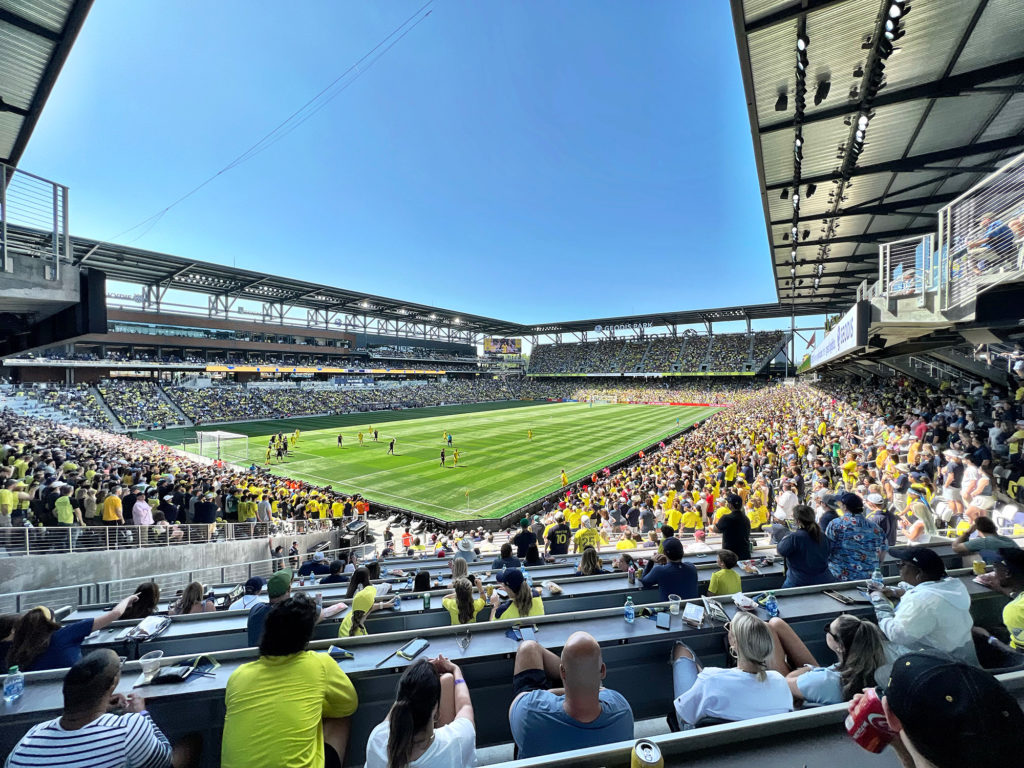
The Kitchen is Open
One of the constants across all large events is food: no matter whether the event is a soccer match or concert, people must eat. Signature food items are also a big part of a venue’s branding. That’s why food offerings always receive plenty of play when discussing a stadium, and that’s why we cover concessions in some depth. We didn’t try all the menu items, of course, but we found some great offerings during our concourse wanderings.
In GEODIS Park, Levy is the main concessionaire, with six local restaurants brought in as food partners. Nashville is a foodie paradise, and the offerings from these locals are noteworthy. In an ideal world, every food sale at a sporting event is sold first by smell, so it’s no surprise the lines were solid at Central BBQ, where the smoke was an instant lure.
Also worth a stop: Prince’s Hot Chicken sandwich. Can’t make a Nashville run without some hot chicken, and Prince’s is known offering some of the best hot chicken in the area. Fried chicken is not exactly a stadium-friendly offering, though, but a hot chicken sandwich was on the Prince’s menu. Eat one topped with Miss André’s sauce, and grab extra napkins.
Another nontraditional stadium offering worth a stop: the Chivanada beef and chicken empanadas. As it ends up, these turnovers are perfectly suited for stadium consumption, with an interesting crispy shell.
For those seeking more traditional stadium fare, there are stands offering your basic hot dogs, pizza, beer, etc. There are stands offering elevated versions as well, including Daddy’s Dogs and Rock’n Dough Pizza & Brewery. And there’s also an extensive list of offerings in the clubs, including sliders and sandwiches. The food at GEODIS Park is varied enough to give fans a chance a totally different experience during every visit to the stadium.
In the End
GEODIS Park’s place in American soccer history was already assured upon opening as the largest American soccer-specific stadium. By launching with a series of sellouts, Nashville SC validated that decision, and if concerts come close to selling out, that decision will be doubly validated. True, Nashville is a unique market on so many levels, but a successful 30,000-seat stadium may lead to some MLS teams to approach new stadiums in a different light, and may cause some existing owners to debate stadium expansions.
This article first appeared in the weekly Soccer Stadium Digest newsletter. Are you a subscriber? Sign up here!
